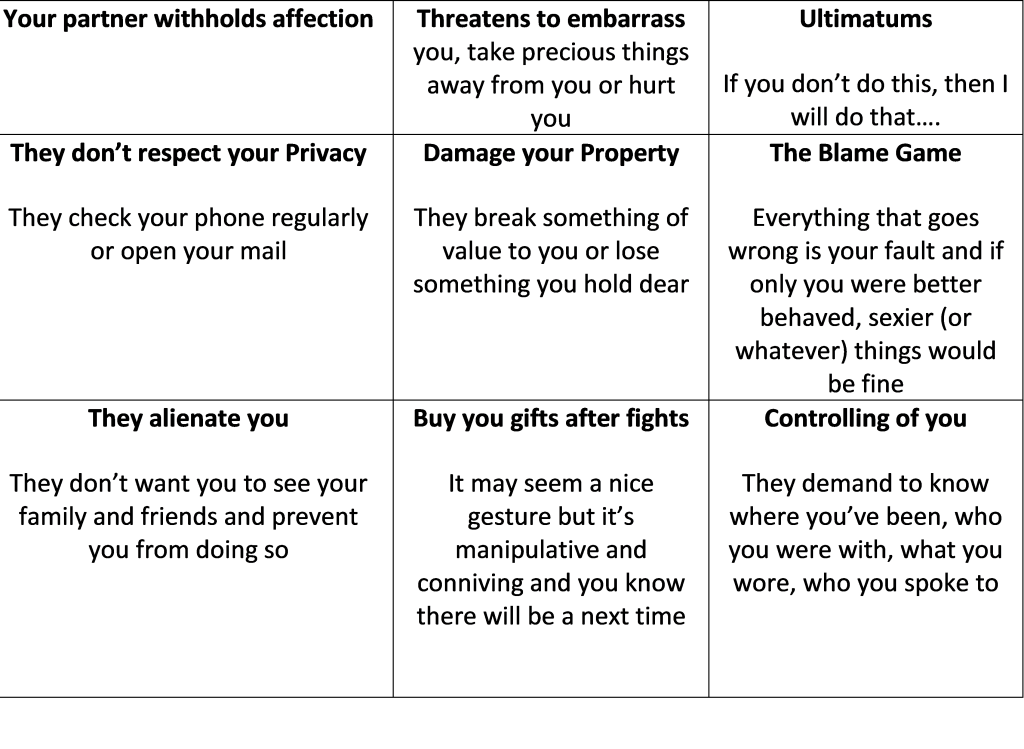Countless women over the years have come to see me about their relationships that are not working – the couple is no longer ‘getting along’, conflict is ever present, violence is often lurking and overall, they are desperately unhappy.
The domestic violence statistics in Australia are well known. 1 women dies a week from DV and the focus of Government funding has been on reducing (or eliminating) abuse over time. We have a long way to go.
Emotional abuse is one form of DV
The impact and severity of emotional abuse is often ‘overlooked’ because it does not leave the person with physical scars, but it can have a significant impact on their confidence and self-esteem – even their life. Emotional abuse comes in many forms, which might not be obvious at first and because of this, many women are living in abusive relationships and don’t even know it.
What is emotional abuse?
Countless unhealthy relationships have emotional abuse in their midst and can be difficult to assess as often the perpetrator is emotionally abusive covertly – when others aren’t around. In being emotionally abusive, the aim of the perpetrator is to make the other person feel inadequate, small, insignificant and unworthy. At the heart of all types of domestic violence is control and power of one person over another, which is classic in emotional abuse.
Many women endure put downs and name-calling over many years. Over time, they lose confidence and self-belief and start to think that what the perpetrator says about them is true.
For example, Sally was told so often by her husband Matt that she was stupid and fat th
at she came to believe she was and never applied for any jobs she could have easily done, never went out at night and started to become a recluse. She believed what her husband accused her of and her life changed. She became anxious and depressed. It was only after realising how abusive he was (her friend kept telling her) and she sought and received help, that she could see how wrong his abusive behaviour was, and she moved out of the relationship.
In an emotionally abusive relationship, women often feel that there is no way out or that without her partner she’ll have nothing. She couldn’t be more wrong.
Signs of emotional abuse
Emotional abuse is a particularly dangerous form of abuse because often it happens over a period of time and many women don’t even realise it’s happening until they are far into the relationship. On top of that, women often make excuses for their partner, justifying their behaviour because ‘they’re having a bad day’ or ‘things aren’t good at work.’ There is no excuse for any type of abuse.
Emotional abuse is a slow process of one person taking control and dominating another (mostly women, but not always) and when she realises it is happening, her self-esteem and sense of worth is already so low, she questions if she can leave him.
Emotional abuse can involve any of the following:
- Verbal violence – screaming at you, insulting you or swearing at you
- Rejection – pretending not to notice your presence, or ignoring your what you say
- Put-downs – calling you names, blaming you for everything that goes wrong, embarrassing you in front of others, telling you that you are stupid or fat or ugly or not clever enough, for example
- Making you fearful– making you feel afraid, intimidated or threatened
- Socially isolating you – limiting your freedom of movement, stopping you from contacting other people (such as friends or family)
- Financial dependence – controlling or withholding money, preventing you from working, stealing from you
- Bullying – purposely and repeatedly saying or doing things that are hurtful to you and designed to shake your confidence
Take the Emotional Abuse test
Have a look at this grid below and ask yourself if any of these occur in your relationship:

The impact of emotional abuse
Physical violence is often seen as being more serious than emotional abuse, but this simply isn’t true. The scars of emotional abuse are real and long lasting. As well as having a negative impact on your self-esteem and confidence, emotional abuse can leave you feeling depressed, anxious and even suicidal.
Once the cycle of emotional abuse begins in a relationship, generally it only gets worse. The cycle of domestic violence happens over time. Slowly at first and then becomes more regular. To reduce or stop it, you will need help, particularly if it has been going on for some time.
What to do
- Be aware that you are being emotionally abused
- Know your rights and that you don’t deserve this treatment
- Don’t retaliate. It could put you in more danger
- Above all else, stay safe and keep your children safe
- Seek help. Get the assistance of a professional person to guide you
- Leave. Stay with parents or friends but remove yourself from the situation. If physical violence exists within your relationship too, seek professional assistance about how to leave. It may be you need help to go into a women’s refuge with your children at the outset
- Cut off contact once you have left
Not all women are in great relationships. Some are toxic, others problematic. Many women struggle to under what a good and happy relationship looks like. Others are in abusive relationships but don’t know it – constantly excusing their partner’s behaviour for one reason or the other.
Stage 3 of our Be Unstoppable online empowerment Program for women addresses the role that trust, love and safety play in relationships and how to create a happy and lasting relationship as a woman.
See www.empoweringwomentothrive.com or go to www.carynwalsh.com.au
Or you can chat with us about any concerns or are being affected by emotional abuse. Book a free discussion at https://my.timetrade.com/book/QGY21
Photo by Nathaniel Flowers on Unsplash

